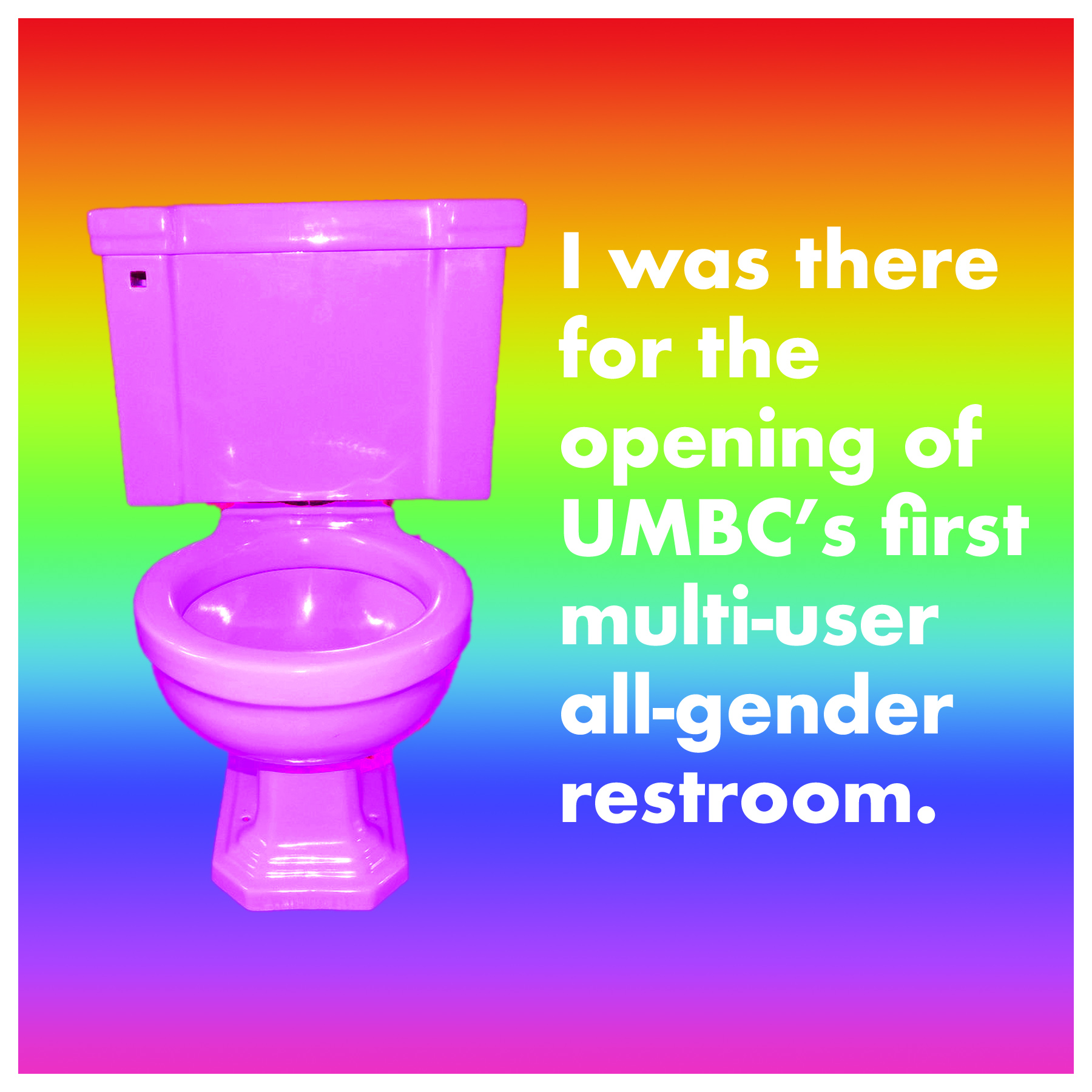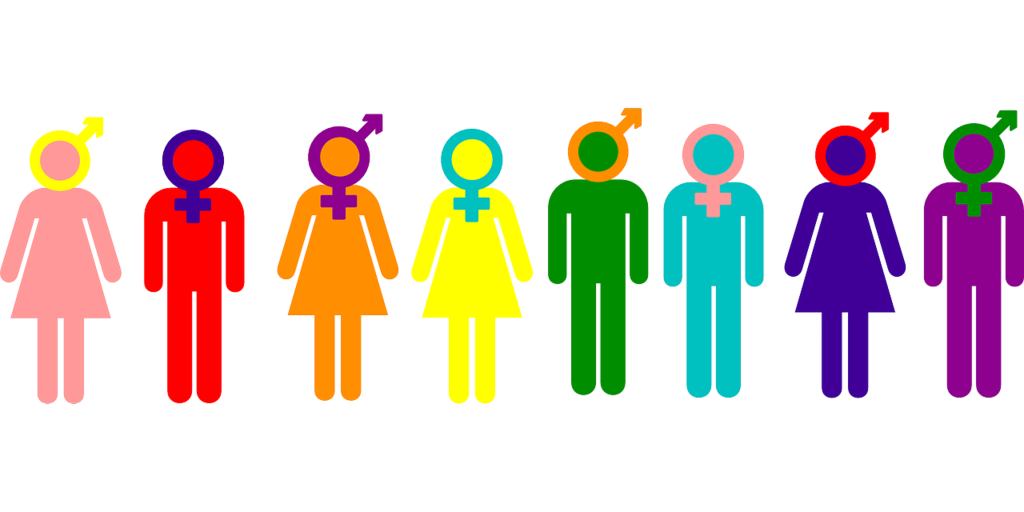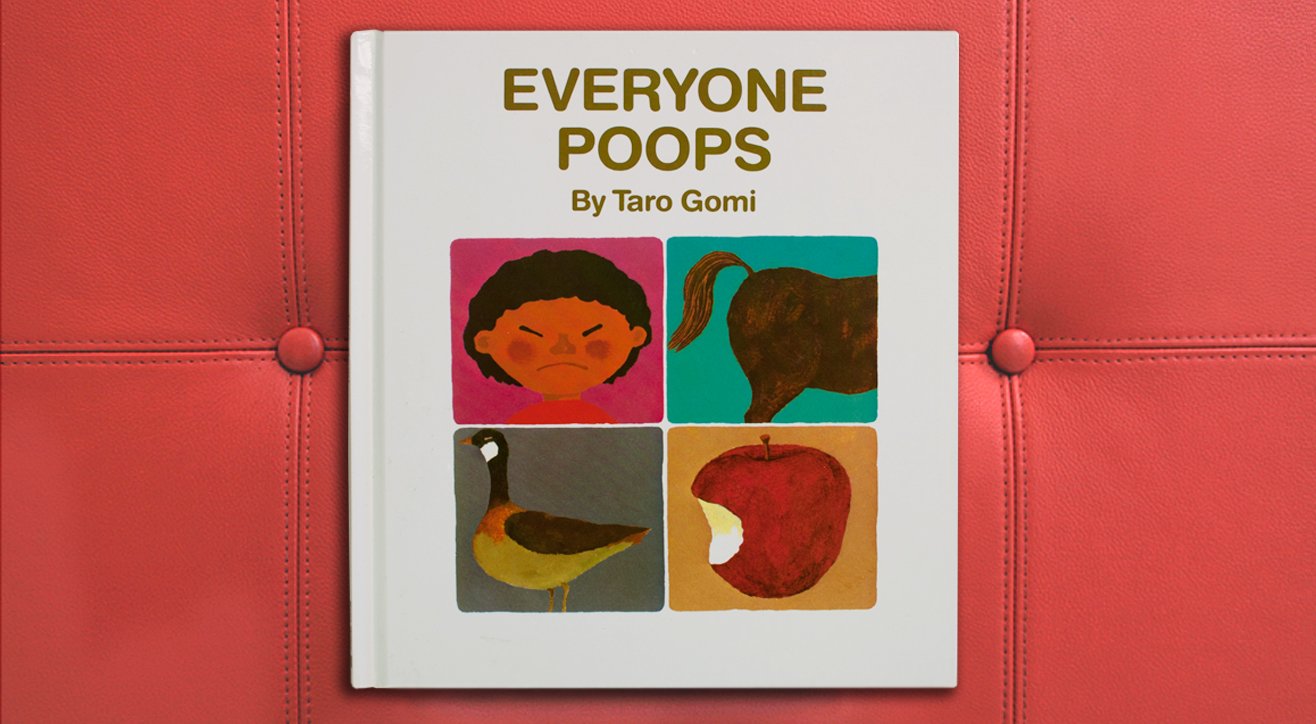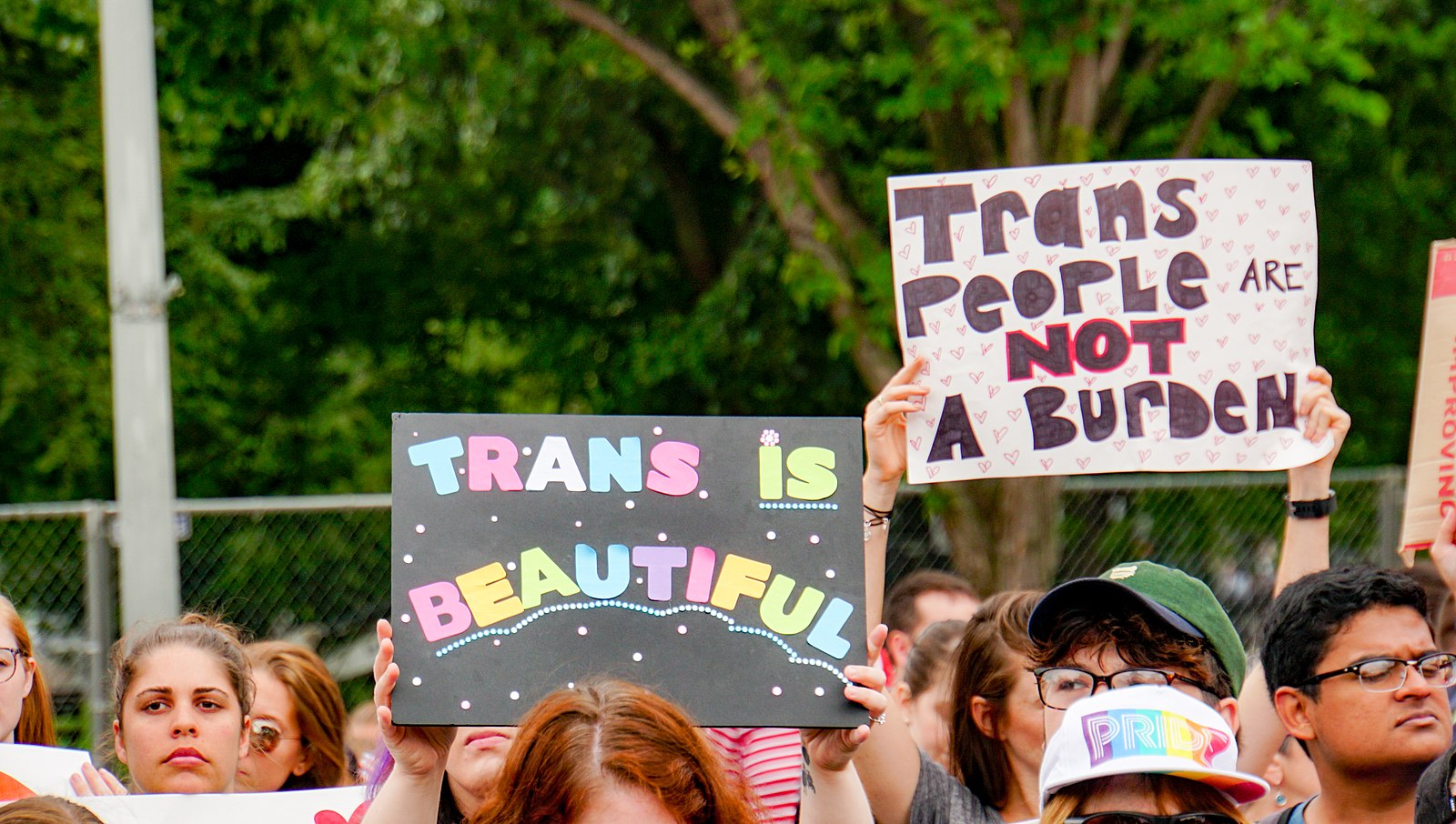Written by Women’s Center Coordinator Amelia Meman, ’15.

With the recent opening of UMBC’s first ever multi-user/stall all-gender restroom, I have become incensed to finally publish this very argumentative blog on all-gender restrooms. In this piece, I’m trying to deconstruct all of the myths, misgivings, and misinformation surrounding all-gender restrooms, and offer some ways of seeing (and potentially peeing) differently.
The MYTH of All-Gender Restrooms: Creating all-gender restrooms is dangerous because it provides an opportunity for sexual predators to attack vulnerable populations (women and children).
The REALITY of All-Gender Restrooms: They exist and have existed for a while through anti-discrimination protections and there is literally no evidence that these policies and the creation of all-gender restrooms lead to more attacks on anyone.
The REALITY of All-Gender Restrooms, Pt. 2: In creating and actualizing discriminatory policies that relegate particular people to particular bathrooms, we increase the likelihood of violence against vulnerable populations–in this case, trans and gender non-conforming folks.
We’re a STEM-heavy school, so let me put it this way: there is absolutely no empirical evidence that would support the hypothesis that increasing access to all-gender restrooms also increases violence against vulnerable populations like women and children.
Fine, done, end of blog.
Just kidding.
I want to continue deconstructing this myth and how damaging it is to the transgender folks in our world—and subsequently, how the perpetuation of this myth is totally antithetical to UMBC’s values of inclusive excellence, diversity, and social justice. So let’s dive in:
The myth of all-gender bathroom bills promoting violence against women and children implies two other dangerous notions that need be dispelled:
- Trans people = sexual predators
- Transgender people do not have the “correct genitalia” to use with their respective gender’s restroom (“if you have a penis, you need to use the men’s restroom”)
First: Who are the “sexual predators” we keep referring to?
Let’s take this first one apart, “trans people = sexual predators.” This line of thinking stems from the (not so distant) historical pathologization of people who don’t conform to socially constructed gender roles; AKA “trans people are crazy and dangerous.”
Not to totally historicize this issue because it is still a present challenge, but in the past, any and all people with non-heterosexual, non-traditional gender conforming identities were considered sexual deviants. In the early 20th century, a sexual revolution in Europe was pushing the boundaries of the way these “sexual deviants” were understood, especially through a medicalized and scientific lens. A cure to deviancy was no longer about keeping problematic individuals away from the public, but around diagnosis and treatment.
Time rolls on and we move through many sexual revolutions, progress, trans and LGB icons, marches, revolutions, etc.. If you were transgender in this time, then you had “gender identity disorder,” a mental illness through all of the American Psychological Association’s (APA) editions of the Diagnostic and Statistical Manual of Mental Disorders through the Fourth Edition (DSM-IV; AKA the Bible of psychiatry and other mental health practitioners). Thus, the idea of transgender people as those who are mentally ill is cemented by The Experts.
Fast forward to 2013: the DSM-V (the fifth edition of the DSM published by the APA in 2013) now uses the term “gender dysphoria” to describe the distress associated with not being able to be the gender we are. The difference here is very nuanced but important. To quote the APA, “gender nonconformity is not in itself a mental disorder. The critical element of gender dysphoria is the presence of clinically significant distress associated with the condition.” In other words, it’s not that being trans or non-binary is crazy. It’s that not being able to be the gender you are (and the barriers society constantly throws up) results in gender dysphoria.
We need to dislodge the synonymity between “transgender” and “problem,” because people are not problems; gender is not a problem. The barriers that we have put up between people accessing (or even just experimenting with being) our truest selves, is the problem.
Second: “But what if a man in a dress uses a women’s restroom”
This is the token visual that opponents of all-gender restrooms look towards. We’ve all seen and experienced this joke: a big burly masculine man is in a hyper-feminine outfit. We’re made to laugh at how these two things don’t go together—but this “joke” is founded on the idea that people who look particular ways have to also act and present themselves in a way that matches our assumptions. This is what we like to call “gender essentialism.”
Gender essentialism/biological essentialism is the idea that there is a particular set of female or male genitalia that indicates your gender (e.g. penis = man; vagina = woman), and therefore should be the criteria by which people act, dress, use a bathroom, etc. The insistence that people with certain biological criteria or physical characteristics are particular genders is an essentialist way of thinking–and it’s also a restrictive way of thinking.
Most of us grow up learning to think as biological essentialists. We’re often taught about sex/gender binaries in our health class or with our parents, right? We’re taught that women, girls, females have vaginas, breasts, hips, higher voices, XX chromosomes; men, boys, males have penises, testes, facial hair, lower voices, XY chromosomes.
Biological essentialism rules the rhetorical roost of how we think about gender and sex; however, a different way of seeing gender and sex is to understand both as “socially constructed.” This is not to say that gender or sex is something we, as a society, have made up; rather, the meanings we ascribe to each of these things has been made through social patterns, behavior, etc. that are continually repeated until they read as fact. Fact becomes synonymous with objectivity and truth. I’m not trying to get into a philosophical discussion of what social constructionism is and how we should unlearn the meanings we learned about in school (if you want to get into that, see my office hours), but what I’m trying to get to is that biological essentialism is not the only way of seeing the world. We can see through a lens of social constructionism which enables us to do more questioning about the conclusions that we come to.
 A conclusion you could (should) question (always) is how we police gender and sex by creating rules around what each of these is defined as. Not every woman has a vagina. Not every person with a penis is male. People with XY chromosomes can be any gender in their lifetime. People can have a variety of different biological sex characteristics that do not align with the sex or gender they were prescribed at birth.
A conclusion you could (should) question (always) is how we police gender and sex by creating rules around what each of these is defined as. Not every woman has a vagina. Not every person with a penis is male. People with XY chromosomes can be any gender in their lifetime. People can have a variety of different biological sex characteristics that do not align with the sex or gender they were prescribed at birth.
To go all the way back to that initial worry that a “man in a dress” will pee next to your daughter or your grandma or you, we can use a more inclusive lens for thinking about this scenario: three people have to pee. There are three private stalls in which they can do their business. These three people pee however it is they do so, and they simultaneously respect each other’s privacy. These three people might look all different sorts of ways, but it doesn’t matter because they came into the bathroom with the same goals–and having completed those goals, wash their hands, and exit in peace and respect.
My final word on this (as if I haven’t had enough already): If you dream of world peace, consider also dreaming of world where all people pee in peace.
Fact Sharing
Okay, so I hope my mythbusting was validating, revelatory, or rote for you. Either way, here’s a fact that I want to share to displace the ugliness above that many opponents like to spread.
FACT: All-gender restrooms are an issue of discrimination and access.
Let’s break this down the same way we did the myth:
First: All gender-restrooms undoing discrimination
When we tell particular people that they are too different to use the bathroom they feel comfortable using, we are ultimately telling people that they are not, in some way, worthy of being in the space they deserve. This is discrimination.
Some folks in this world believe that by pressing for progress in trans rights, we are, among other misguided notions, setting a bad example for our children. But here’s the thing—the more we repress gender fluidity and multiple ways of being, the more undue violence we are perpetrating against children as they understand themselves as individuals. The tangible effects of discrimination do not come in the form of less trans people; rather, trans people will always exist, have always existed, but they will continue to meet a negative message that causes mental, psychological, and social distress. Not allowing transgender children to live their gender identity is harmful and potentially deadly. When you’re constantly met with the message that you’re too different to belong, you begin to face the alternative of belonging… which is shame and isolation.
We combat discrimination and its effects through inclusive access and affirming care. Hence, the importance of all-gender restrooms and ensuring their creation.
Second: All-gender restrooms as practical solutions to access issues
I want to bring this back to UMBC for a second with a little test: Do you know where the closest all gender restroom is?
If you do, congratulations. If you don’t, you’re not alone.
In total, there are almost 60 all-gender restrooms on our campus.
In the Commons? Two.
In the University Center? One.
And these are all just single-use restrooms.
Regardless of what you think in terms of trans rights or issues of identity, it’s a fact that UMBC is home to folks who live outside of the binary and those who are not cisgender. Whether they identify as trans, nonbinary, genderqueer, etc., they should be able to use a bathroom without having to search an entire building for the one restroom that exists.
The Williams Institute performed research on how transgender students with limited public restroom access were impacted by these restrictions. In their study, they found that those who experience problems accessing restrooms consistent with their gender identity report greater absenteeism, poorer school performance, withdrawing from public spaces and events, physical and mental health impacts (such as bladder infections, discomfort, and anxiety), having to change schools, or dropping out.
Wrapping Up
Did you read Everyone Poops? Truly a seminal piece of children’s literature, the message rings true even in today’s modern world. Everyone poops. Everyone needs bathrooms. As teachers, workers, students, people living in this world in the soft fleshy body we call Homo sapien—we need to have an efficient, clean, accessible method for disposing of our waste. We have actually found the key in publicly available toilets and bathrooms. As a frequent user, I endorse that they’re pretty fantastic in a pinch, even if they’re stinky or crowded or awkward.

If I’m dreaming, I believe that one day, maybe we will find the technology that allows all people on this earth to shirk public restrooms, but until that day… please just let people use the toilet in peace—and if you’re feeling fired up about ensuring other people’s access, see the resources below for ways you can help out.
Finally, if you don’t like all-gender restrooms, you don’t have to use them. But as our campus and many other places progress in ensuring broader access to all-gender restrooms, it might be a nice experiment in perspective building to go in search for that rare one gender bathroom all the way across campus that affirms your identity, that you feel totally safe in, and in which you can use the bathroom however you need to.
See what I did there?

Student leader, Autumn, standing with a balloon arch we made to celebrate the opening of UMBC’s first multi-user all-gender restroom.
Resources and further reading:
UMBC All-Gender Restroom Map (2019)
UMBC Community News Message on All-Gender Restrooms from President Hrabowski and Provost Rous
GLAAD Report: Debunking the Bathroom Bill Myth (2017)






